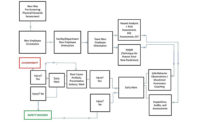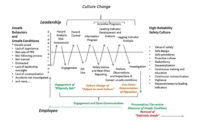As discussed, in some hazard situations, there are legal requirements that employers must meet if within certain parameters such as having ten or more employees, having certain hazards present within their operations and more (OSHA, n.d.). In other cases, even without regulatory requirements, national consensus standards from the Center for Disease Control (CDC), the National Institute for Occupational Safety and Health (NIOSH) and other agencies exist (CDC, n.d.). In yet other cases, even with regulatory or national consensus standards, a recognized workplace hazard still requires due diligence in hazard control as per the General Duty Clause of the Occupational Safety and Health Act of 1970 (OSHA, 1970).
However, it is at this point that a certain level of ambiguity sets in. Short of regulatory standards or peer-reviewed guidance, or even in the context of organizations determining whether they will comply with these standards or to what degree of diligence they will pay to hazard control, organizational risk management processes become matters of perception and opinion. This perception and opinion can even exist at the federal legislative and executive levels; the Trump Administration has deregulated workplace safety (Kullgren, 2018), environmental (Popovich, Albeck-Ripka & Pierre-Louis, 2020) and a plethora of other areas (Brookings, n.d.). In other cases, Senator Mitch McConnell has led efforts to develop liability protection for employers from compensation cases rooted in COVID-19 exposures regardless of the employer’s diligence in exposure prevention (Mueller, 2020).
In fact, the case of the 2020 COVID-19 pandemic is an unfortunate example of subjectivity in workplace safety diligence via risk assessment and perception. Without hard regulations regarding safety requirements to prevent viral exposures and, furthermore, heavy-handed efforts by politicians of all parties and levels to sway perceptions of the gravity of the hazard, employers are left to their own perceptions of the hazards — as influenced by politicians and their communications teams based on political messaging (Washington Post, 2020) – and subjective risk assessments to determine what they will do — if anything — to protect their employees.
Determining diligence
In the case of a hazard analysis, the hazard identification is first performed to determine what hazard exists. Afterwards, the at-risk population is determined. From this point, the risk assessment is conducted by determining the risk level of the hazard. Based on frequency of exposure – how often teams may be exposed to the hazard – and severity of exposure – how bad the outcome could be should the hazard manifest itself – the risk assessment is a hybrid qualitative and quantitative process that concludes with a risk assessment code based on the organization’s risk matrix. In some cases, this risk matrix will both determine the risk level but also dictate to what extent that hazard and risk will be allowed to persist in the organization’s activities. For example, in some organizations, risk matrices exist that annotate what hazard frequencies and severities exist that could lead to a fatality(ies) and, more so, whether the organization is willing to accept that risk (Worden, 2015).
At its core, “ethics” can be defined as “the values an individual uses to interpret whether any particular action or behavior is considered acceptable and appropriate” (Stanwick & Stanwick, 2009). Furthermore, “business ethics” can be defined as “the collective values of a business organization that can be used to evaluate whether the behavior of the collective members of the organization are considered acceptable and appropriate” (Stanwick & Stanwick, 2009). Through this process, the first indicator of an organization or individual’s risk and safety perception and, by effect, the organization’s ethical posture, is how much risk and resulting injuries, exposures and deaths it/he/she is willing to accept.
Dangers of subjectivity
This is the first point in which subjectivity presents itself. If an organization, or even an individual(s), believes, even without basis, that the frequency or severity of the hazard is low, the risk assessment can be artificially lowered. Furthermore, this artificially lowered risk assessment can then be used to seemingly validate decisions to what controls – if any – will be implemented to prevent exposures to the hazard. As discussed, with information being determined in real-time regarding the COVID-19 virus during the winter and spring of 2020, the Trump Administration took to the White House Press Room to - without scientific basis and, in some cases, in spite of scientific evidence to the contrary – proclaim a downplayed version of the viral hazard (Lantry & Ebbs, 2020), promote unproven medications (Cathey, 2020), support claims that hazard controls such as source control via face mask use are not needed (Stracqualursi, 2020) and support conspiracy theories (Liptak, 2020). With this, this executive, presidential influence to lower guards against COVID-19, even as the President himself stated he was aware of the imminent dangers of the virus, played into organizational risk assessments across the country when determining how to protect employees, including the President’s direct contradictions of the Center for Disease Control’s recommendations (Klein & Liptak, 2020).
For employers to determine their risk assessments, available information is analyzed to determine the risk treatment option best for them. In the case of COVID-19, countless social media posts exist and have existed over the months of the pandemic expressing concern that, because the person writing the post was not directly affected by the pandemic, the pandemic must not be as ‘real’ as the CDC and other science-based agencies had communicated or may not be real at all. This has then led to conspiracy theories that the pandemic was a political creation intended to deny rights, violate privacy and create an authoritarian government (Liptak, 2020).
If this is the type of information being assessed, especially without consideration of the infinite amounts of other perspectives and experiences, not to mention hard scientific evidence, the risk assessment will be fundamentally flawed. Furthermore, following the risk assessment, hazard controls — or a lack thereof — will be implemented. This is the point at which an organization or individual’s perception-based risk assessment translates into what will or will not be done to protect employees in the face of the assessed.
Risk treatment
Once an organization or individual has determined the perceived risk level of the hazard in question and, based on this assessment, how much risk is willing to be lived with, the next step is then to determine how much hazard/risk control to provide to maintain that level. For example, if an organization believes COVID-19 to be high frequency and high severity and can cause numerous fatalities, that team must now determine what it will do to maintain an acceptable level of control up to closing their business.
However, if the organization, based on facts and science or perceptions and opinions aside, determines that the virus is not a high risk — and with no hard regulations surrounding it — that team can decide to not attempt to control viral exposures at all. This has happened with many organizations; one example would be a Florida Sheriff’s Department in which the Sheriff banned his deputies from wearing facial coverings during the COVID-19 pandemic despite CDC guidance based on his personal risk perception (Ashmelash, 2020).
In the landscape between closing business to prevent person to person contact and bypassing all scientific guidance, all decisions based on organizational and individual risk perception, a methodological approach exists to determine the most effective means of hazard/exposure control for the determine level of risk. This process includes the following options:
- Risk Acceptance – choosing Risk Acceptance, the organization or individual is choosing to not implement any controls and to accept the hazard as is along with any harm that may come from it.
- Risk Transfer – choosing Risk Transfer may mean to transfer the hazardous operation to another organization or individual, usually with more extensive training or preparedness in controlling the hazard, to transfer the operational location to a less hazardous environment or another means of transfer to ideally lower the risk.
- Risk Avoidance – choosing Risk Avoidance is the organization or individual choosing to bypass the operation or otherwise avoid the hazard to prevent the need to control or accept it.
- Risk Control – choosing Risk Control is to continue the hazardous operation but with hazard controls implemented to lower the risk; to choose Risk Control is to also choose a subsequent hazard control(s) from the following:
- Regulations, standards and other guidance – as previously discussed, some hazards have predetermined hazard controls required for them as fundamental requirements.
- Hazard elimination – if the hazard can be eliminated, this is preferable as the most effective hazard control.
- Hazard substitution – if the hazard can be substituted for a less dangerous hazard, this can be effective; a common example is a chemical in use that has inherent hazards – if another chemical that serves the same purpose but is less dangerous can be substituted, this lowers the operational risk.
- Engineering controls – if the risk can be controlled by a physical solution such as a barrier, ventilation or another mechanical means, this is a highly effective control.
- Administrative controls – if a process can be modified to limit or reduce the hazard’s exposure time, this can also be effective.
- Personal Protective Equipment – if no other hazard controls can be implemented, PPE can often be used to at least cover up the exposed personnel; for example, in clinical operations, PPE can be used to keep blood or body fluids off a Nurse when no other controls can be used.
- Other necessities – regardless of what hazard control(s) are implemented, training for all at-risk personnel on those controls is needed; likewise, situational awareness training to identify the hazard in real-time is needed (Worden, 2020).
When a hazard is identified and the risk assessment is completed, an objective assessment is needed to determine the risk level through the best-known frequency and severity of the hazard and the risk treatment method(s) must be chosen based on it. With thorough, valid and reliable inputs to these assessments such as the properties of the virus, infection rates, statuses of vaccines and medical treatments, PPE inventories and more, the subjectivity of the assessments can be lowered to improve the safety of the operation. However, if personal opinions, political positions, disinformation or other factors become parts of the risk assessment, an unsafe risk treatment method (such as Risk Acceptance when Risk Control can be used) or ineffective hazard controls (such as using PPE when an engineering control can be used) may be chosen. Decisions like these, when unsafe, put team members at risk, sometimes due to someone’s opinion or an unfounded political message.
In effect, these risk assessments and their resulting hazard controls can only be as good as the information analyzed to create them. This creates a very notable ethical dilemma in terms of whether the organization is best protecting its employees or only catering to its decision makers’ political preferences. To understand this situation, the foundation of perceptions first needs viewed, followed by the ethical dilemmas it creates.
The Origins of Perceptions
“Most people in America right now think of Iraq as a dangerous country. Now, if I were to stand up, I might get killed. But to us, behind this wheel, it's pretty safe. So, to us, Iraq is a safe country. Right here, I feel pretty safe.” – ‘Lt. Nathaniel Fick’ in “Generation Kill” (Simon, Burns & Wright, 2008)
In the HBO mini-series, “Generation Kill,” based on Evan Wright’s nonfiction work and a script by Wright, David Simon and Ed Burns, a character, Lt. Nathaniel Fick, based on the real-world platoon commander of the unit portrayed in the television series, explains to a war correspondent journalist that, despite the ongoing war in Iraq, their location, their actual position behind the wheel well of a two and a half ton truck makes their personal location relatively safe. Their perception of risk is very different than someone else ten feet away without the cover and concealment blocking incoming bullets. There are multiple – possibly infinite – variations of reality, even among just a few people, and unless decision-makers seek out more information than their own – possibly biased – perceptions, a high risk exists that personnel will be placed at an even higher risk. These types of perception-based decisions often influence or directly lead to resulting decisions as to what resources and protocols will be developed to protect others. This can lead to ethical dilemmas.
In part three of this series, the important role of ethics will be explored and why it is so important that personal perceptions do not interfere with risk assessments and have undue effects on hazard controls.



